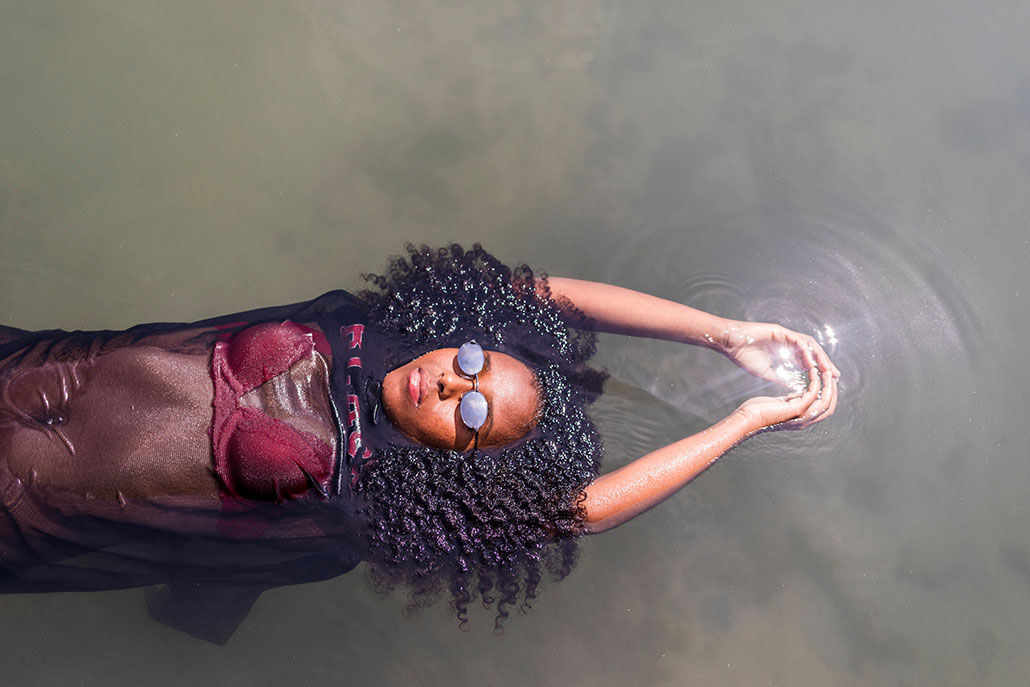How to Protect Hair from Chlorine: The Complete Guide for Natural Hair

Regular shampoo simply can’t protect your hair from chlorine damage – but these proven strategies can.
Chlorine strips natural oils from hair proteins, causing up to 40% tensile strength reduction in frequent swimmers, with highly textured hair (4B-4C) showing 40-60% more visible damage than straighter textures. This comprehensive damage occurs through disulfide bond disruption and protein denaturation, making preventive care 3-5 times more cost-effective than repair treatments. Professional swimmers show complete cuticle loss and significant structural changes within just 2-4 weeks of daily exposure, while proper pre-swim preparation and specialized products can reduce chlorine absorption by 40-60%.
Understanding chlorine’s devastating effects on natural hair is crucial for anyone who wants to protect their hair while swimming. Research from elite Japanese swimmers demonstrates that 61% showed hair discoloration compared to 0% in non-swimmers, with complete disappearance of hair cuticles observed under electron microscopy. For the natural hair community, learning how to protect hair from chlorine becomes even more critical due to structural vulnerabilities inherent in textured hair patterns.
How chlorine destroys hair at the molecular level
The chemical warfare between chlorine and your hair occurs at the protein level, where chlorine acts as a powerful oxidizing agent that systematically dismantles your hair’s structural integrity. Hair consists primarily of keratin protein containing 18% cysteine residues—sulfur-rich amino acids that form critical disulfide bonds maintaining hair strength and curl pattern.
When chlorine encounters these proteins, it breaks the covalent disulfide bonds between cysteine residues, causing protein chains to lose their stable configuration. This biochemical disruption leads to immediate cuticle lifting, creating a “bulldozer effect” that exposes the inner cortex to further damage. The formation of hypochlorous acid when chlorine dissolves in water penetrates cells and strips sebum—your hair’s natural protective barrier—from both scalp and hair shaft.
Research demonstrates quantifiable protein loss in chronically exposed hair: cysteine content reduces by 15-30%, overall amino acid composition alters, and keratin-associated protein ratios change dramatically. Studies show swimmers’ hair has significantly lower sulfur content than controls, with elemental chlorine detected in all damaged samples.
The damage progression follows a predictable timeline: Week 1-2 brings cuticle lifting and increased porosity, weeks 3-6 show protein loss with 15-25% tensile strength reduction, weeks 7-12 reveal color changes and significant structural damage, while 3+ months results in irreversible cuticle loss and up to 40% strength reduction.
Why learning how to protect hair from chlorine is critical for natural textures
Understanding how to protect hair from chlorine becomes even more important for natural hair textures. Type 4C hair shows the highest vulnerability to chlorine damage due to its unique structural characteristics. The tightly coiled pattern creates multiple stress points along each strand, while the thinner cuticle layer provides less natural protection compared to Asian and Caucasian hair types. Natural dryness makes highly textured hair particularly susceptible to chlorine’s dehydrating effects, and sebum struggles to travel down coiled strands, offering minimal natural defense.
Hair porosity creates differential damage patterns across natural hair textures. Low porosity hair (common in 2A-3A textures) initially resists chlorine penetration due to tightly closed cuticles, but when damage occurs, it’s often more concentrated and severe. Medium porosity hair (typical in 3B-4A patterns) shows moderate chlorine absorption with balanced responses to protective treatments and gradual damage progression. High porosity hair (prevalent in 4B-4C textures) readily absorbs chlorinated water through raised cuticles, showing immediate visible effects and increased susceptibility to protein loss.
The surface area exposure differs dramatically between hair types. Tightly coiled 4C hair presents significantly more surface area to chlorine contact compared to straighter textures, while the natural curl pattern creates additional stress points where chemical damage concentrates. Research indicates breakage occurs 2-3 times faster in highly textured hair, with color changes more pronounced due to higher absorption rates.
Swimming frequency creates cumulative damage that compounds over time
Professional swimmers training daily for 2-4 hours show visible damage within 2-4 weeks, while frequent recreational swimmers (3-4 times weekly) notice changes in 6-8 weeks. Moderate swimmers (1-2 times weekly) experience minimal damage primarily limited to dryness, and single exposures cause immediate but temporary effects, mainly cuticle lifting.
The landmark 2000 study published in the Journal of Dermatology examined 67 elite swimmers versus 54 age-matched controls, revealing that 61% of swimmers showed hair discoloration versus 0% in controls. Electron microscopy revealed complete disappearance of hair cuticles, with sulfur content significantly lower than controls and elemental chlorine detected in all swimmers’ damaged hair samples.
Pool chemistry dramatically impacts damage rates. Standard pools (1-3 ppm chlorine) cause gradual damage with repeated exposure, while over-chlorinated pools (above 5 ppm) accelerate damage with immediate effects. pH levels above 7.8 increase alkalinity and amplify damage, while combined chlorine exposure with UV radiation creates exponentially increased damage rates.
Recovery potential varies by exposure duration: mild damage (1-4 weeks exposure) shows 60-80% recovery with proper treatment, moderate damage (1-3 months) allows 30-50% recovery, while severe damage (over 3 months daily exposure) permits less than 20% recovery, primarily cosmetic improvements.
How to protect hair from chlorine: The most effective ingredients according to research
Step 1: Create a protective barrier before swimming
Coconut oil demonstrates superior penetration and effectiveness in preventing protein loss caused by chlorine while reducing hair porosity. Scientific studies show coconut oil’s unique molecular structure allows it to penetrate the hair shaft more effectively than other oils. Olive oil, rich in vitamins A and E, helps preserve keratin proteins, while argan oil provides deep moisturization and antioxidant protection.
Application method proves crucial for oil effectiveness: applying oils to damp (not dry) hair before swimming provides optimal protection by creating a hydrophobic barrier that prevents chlorine absorption. However, pool etiquette considerations require moderation—excessive product application can contaminate pool water.
Step 2: Use targeted leave-in protection
Leave-in conditioners create protective barriers against chlorine absorption while providing continuous moisture. Key ingredients include water-soluble silicones that create slip and protection, and humectants that draw moisture to hair. Silicones offer varying protection levels: water-soluble varieties like Amodimethicone provide protection without heavy buildup, while non-water-soluble silicones offer superior protection but require clarifying shampoo removal.
Research demonstrates that keratin peptides can partially restore damaged disulfide bonds, with peptide treatments improving mechanical properties by up to 40%. These amino acid chains interact with damaged hair proteins, forming new intermolecular bonds that strengthen the hair structure.
How to protect hair from chlorine: Why specialized products outperform regular shampoos
Step 3: Remove chlorine with specialized formulations
The fundamental difference lies in chelating agents—compounds that bind and remove chlorine and metal ions from hair. EDTA serves as the gold standard chelator, effectively binding calcium, magnesium, copper, and chlorine ions at optimal pH levels. Sodium gluconate provides a gentler alternative effective across wider pH ranges, while citric acid offers natural chelation for sensitive hair types.
Regular shampoos completely lack these specialized chlorine-neutralizing compounds, metal ion removal capabilities, pH adjustment formulations for chlorine exposure, and adequate moisturizing agents for chemical damage repair. This fundamental formulation difference explains why regular shampoos fail to protect hair from chlorine damage.
Essential ingredients to prioritize in swimmer’s shampoos include primary chelating agents like EDTA, moisturizing systems combining oils, proteins, and humectants, pH optimization maintaining slightly acidic range, and antioxidant protection through vitamins C and E or plant extracts.
Your complete chlorine protection system:
The Dive-In Shampoo represents the gold standard for how to protect hair from chlorine with its revolutionary formulation that combines sulfate-free clarifying with powerful chlorine removal. This game-changing formula features sodium C14-16 olefin sulfonate for gentle yet effective cleansing, disodium EDTA for complete chlorine neutralization, and an intensive moisturizing blend including shea butter, sunflower oil, coconut oil, and castor oil that prevents the harsh dryness typical of clarifying shampoos.
What makes Dive-In Shampoo the ultimate solution for how to protect hair from chlorine? Unlike regular shampoos that simply clean surface dirt, this specialized formula actively seeks out and removes chlorine molecules while simultaneously replenishing your hair’s natural moisture barrier. Customer testimonials confirm its effectiveness: “I was in search of a shampoo that would get rid of the chlorine water that would stay in my hair even after showering. My hair was so crunchy and dry… it has worked wonders! My hair feels so soft and refreshed.”
Complete your chlorine defense system with the Dive-In Conditioner, specifically formulated to restore moisture and seal the hair cuticle after chlorine exposure. This intensive treatment works in perfect harmony with the Dive-In Shampoo to provide comprehensive protection and repair.
Don’t forget total body protection! Chlorine doesn’t just damage hair – it strips your skin’s natural protective barrier too. The Swimmers Body Wash completes your total-body chlorine defense, gently removing chlorine while nourishing your skin with moisturizing ingredients.
Malibu C Swimmers Wellness Shampoo earns professional recognition for its dual chelating system plus vitamin C antioxidant protection in a gentle, sulfate-free formula suitable for daily use. UltraSwim remains the time-tested choice with basic but effective chlorine removal, while TRIHARD offers proprietary Red Algae and Dead Sea mineral blends with menthol cooling effects.
Professional methods: How to protect hair from chlorine according to experts
Step 4: Follow expert prevention strategies
Board-certified dermatologists consistently recommend pre-wetting hair as the primary prevention method. Dr. Daniel Schlessinger explains that “hair cuticles act like a sponge, expanding when wet and shrinking when dry. Wetting your hair prior to getting in the pool will result in your hair soaking up less chlorine while you swim.”
Professional hairstylist Sara Hallajian, an IAT Trichologist, emphasizes that “chlorine is a harsh chemical that pulls out the natural oils from your hair that act as a protectant. Over time, it can weaken the hair shaft, roughen the cuticle layer and even alter hair color.” Her key recommendation: “Rinsing your hair thoroughly is the key to removing chlorine residue before it sets in.”
Celebrity hairstylist Paul Labrecque recommends that “the best way to protect your hair from chlorine is to saturate your hair with fresh water first. Hair that’s already wet when it is exposed won’t be able to absorb as much chlorine.” He notes that chlorine acts as both a mineral and bleaching agent, leaving deposits while changing hair color.
The American Academy of Dermatology’s official guidelines recommend protecting hair by wetting and conditioning before swimming, wearing tight-fitting swim caps, and using specially formulated swimmers shampoos with deep conditioners afterward to replace lost moisture.
Certified trichologist Shab Caspara explains the pH science: “Pool water pH levels greatly differ from the healthy hair pH range, which can cause hair to become more damaged, frizzy, dull and prone to breakage.”
Prevention costs 3-5 times less than damage repair
Preventive care approach costs $26-47 monthly for basic protection, including quality swim cap ($15-30 one-time), clarifying shampoo ($8-15 monthly), deep conditioner ($10-20 monthly), and leave-in conditioner ($8-12 monthly). Premium prevention kits range $60-100 monthly with specialized swim caps, pre-swim protective sprays, swimmer-specific shampoo/conditioners, weekly hair masks, and natural oils.
Damage repair approaches cost dramatically more: basic repair needs run $110-200 monthly including intensive repair products, weekly protein treatments, split-end treatments, and more frequent salon visits. Severe damage repair ranges $280-530 monthly with professional treatments ($75-150 per session), multiple weekly masks, specialized serums, frequent trims, and possible professional consultations.
The break-even analysis shows prevention pays for itself within 2-3 months, providing long-term savings of $200-400+ annually while maintaining hair health instead of constant damage control. For swimmers asking whether preventive care is worth the investment, the mathematics clearly support proactive protection.
The complete guide: How to protect hair from chlorine with proven FAQs
How should I protect my hair before swimming?
Pre-wet your hair thoroughly with fresh water, apply a light coating of coconut oil or leave-in conditioner, secure hair in protective styles like braids, and wear a properly fitted swim cap for maximum protection.
Should I wet my hair before swimming?
Absolutely. Pre-wetting with fresh water is the single most effective prevention step, as saturated hair cannot absorb as much chlorinated water. This simple action can reduce chlorine absorption by 40-60%.
How do I remove chlorine after swimming?
Always rinse immediately with fresh water, use co-wash for frequent swimmers, reserve clarifying shampoo for 2-3 times weekly maximum, and avoid daily shampooing which can strip hair further.
Are swimming caps effective for protecting natural hair from chlorine?
Yes, when properly fitted. Silicone caps provide maximum waterproof protection but can be uncomfortable, fabric caps offer comfort with less protection, and specialized caps like Soul Cap are designed specifically for natural hair, locs, and braids.
What’s better for protecting hair: saltwater or chlorinated pools?
Both damage hair differently. Chlorinated pools are more chemically harsh and strip oils aggressively, saltwater pools contain naturally produced chlorine but with “softer” water, while ocean water provides natural salt that’s drying but less chemically harsh than pool chlorine.
How does hair texture affect how to protect hair from chlorine?
Type 4C hair shows highest vulnerability due to tightly coiled structure creating stress points, thinner cuticle layers, natural dryness, and difficulty with sebum distribution. Breakage occurs 2-3 times faster in highly textured hair, making protection even more critical.
How to protect hair from chlorine: Seasonal strategies that work
Summer protection strategies:
Summer swimming presents compound challenges including increased UV exposure adding to damage, higher temperatures increasing evaporation and dryness, more frequent swimming sessions, and sun plus chlorine creating compound damage. Adjustments should include UV-protective hair sprays, weekly deep conditioning, leave-in conditioners with UV protection, poolside hat wearing, and increased protective styling.
Winter swimming considerations:
Winter swimming challenges include indoor pools with higher chlorine concentrations, heated indoor air causing additional dryness, less natural moisture in winter air, and hair already prone to seasonal dryness. Counter these with increased moisturizing treatments, heavier oils and creams, silk pillowcases to reduce friction, and consistent deep conditioning schedules.
Indoor pools typically maintain higher chlorine concentrations with less natural air circulation and heated environments that increase dryness, while outdoor pools compound UV damage with chlorine damage but benefit from natural air circulation and seasonal water chemistry variations.
Your step-by-step guide: How to protect hair from chlorine with cost-effective routines
Pre-swim routine for maximum protection (5-10 minutes):
Thoroughly wet hair with fresh water for 2-3 minutes focusing on all sections, apply minimal protection with light oil coat if desired, secure hair in protective styles like braids or twists, and use properly fitted swim cap covering all hair.
Post-swim routine for optimal recovery (10-15 minutes):
Immediately rinse with fresh water massaging scalp, gently towel dry with microfiber or cotton t-shirt using patting motions, cleanse appropriately based on swimming frequency, deep condition focusing on ends and damaged areas, detangle carefully starting from ends, apply leave-in products using LOC method (liquid, oil, cream), and air dry when possible avoiding heat styling after chemical exposure.
Weekly intensive care includes deep conditioning treatments for 30+ minutes with heat when possible, protein treatments for high porosity hair every 2-4 weeks, clarifying treatments to remove buildup, and oil treatments for extra nourishment.
The most critical elements for successfully learning how to protect hair from chlorine include understanding that prevention significantly outperforms repair approaches, pre-wetting hair provides more protection than any single product, immediate post-swim rinsing prevents chlorine penetration, quality swim caps offer maximum protection when properly fitted, and deep conditioning remains non-negotiable for swimmers with natural hair.
Swimming doesn’t have to destroy your natural hair’s health and beauty. With proper understanding of chlorine’s effects, strategic use of protective ingredients and specialized products like the complete Dive-In Hair Care System, and commitment to evidence-based prevention strategies, you can master how to protect hair from chlorine while enjoying all the benefits of regular swimming. The key lies in respecting both the science of hair structure and the proven methods that professional swimmers and their hair care teams have refined over decades of experience.
Ready to master chlorine hair protection?
- Start with the Dive-In Shampoo for complete chlorine removal
- Follow with Dive-In Conditioner for intensive moisture restoration
- Complete your routine with Swimmers Body Wash for total-body chlorine defense
Remember: learning how to protect hair from chlorine depends more on what you do before and immediately after swimming than on expensive repair treatments later. Invest in prevention, follow professional recommendations, and your natural hair will thank you with strength, shine, and resilience season after season.

